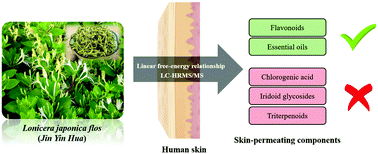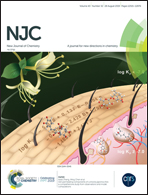Skin-permeating components of Lonicera japonica flos: a comprehensive study from observations and model computations†
Abstract
Lonicera japonica flos (LJF) is widely used for different health benefits in various external preparations in traditional medicines, cosmetics and personal care products. However, its components that are absorbed via the skin remain poorly studied. In the present work, the skin permeability coefficient (log Kp) of known chemical components of LJF was computed using a linear free-energy relationship equation. The results showed that the potential skin-permeating components (SPCs) whose log Kp was suggested to exceed −7.0 included flavonoids, essential oils, phenols and phenolic acids, and triterpenoids, but only a few glycosides. It was further revealed that highly hydrophilic glycosyl groups produced a very adverse effect on the skin absorption of glycoside molecules. The SPCs of LJF methanol extract were collected via in vitro skin permeation experiments, and analysed by LC-MS/MS using an untargeted strategy. A total of 43 SPCs were found, including 13 compounds from the major component classes, namely 9 non-glycoside flavonoids, 1 organic acid (i.e., chlorogenic acid) and 3 iridoid glycosides. The chromatographic peak areas indicated that the detectable absorption of chlorogenic acid and iridoid glycosides with poor skin permeability was ascribed to their high contents in the plant. The experimental observations were in good agreement with the potential SPCs screened, which suggested that the skin permeability of compounds was not influenced by coexisting compounds in LJF. This was also confirmed by the fact that no significant change in skin electrical resistance was observed after the application of LJF methanol extract. To sum up the findings, the flavonoids and essential oils in LJF can enter the body through the skin in terms of good skin permeability and relatively high contents, presumably being effective components of the external preparations. On the other hand, the chlorogenic acids, iridoid glycosides and triterpenoids (mostly present as saponins) are delivered only marginally even when high doses are applied.



 Please wait while we load your content...
Please wait while we load your content...